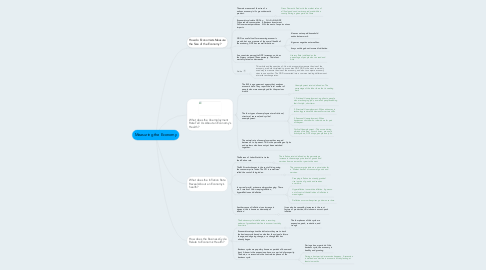
1. How does the Business Cycle Relate to Economic Health?
1.1. The business cycle is defined as a recurring pattern of growth and decline in economic activity over time
1.1.1. The four phases of this cycle are expansion, peak, contration, and trough
1.2. Economists categorize the indicators they use to track the business cycle based on whether they signal a future change, and ongoing change, or a change that has already begun
1.3. Business cycles are populary known as periods of boom and bust. A boom is the expansion phase, or a period of prosperity. The bust, or a recession is the contract-ion phase of the business cycle.
1.3.1. During a boom period of the business cycle, the economy is healthy and growing
1.3.2. During a bust period a recession happens. A recession is defined as a decline in economic activity lasting at least six months
2. What does the Inflation Rate Reveal About an Economy's health?
2.1. The Bureau of Labor Statistics tracks the inflation rate.
2.1.1. The inflation rate is defined as the percentage increase in the average price level of goods and services from one month or year to the next.
2.2. The BLS tracks changes in the cost of living using the consumer price index. The CPI is sometimes called the cost-of-living index.
2.2.1. The consumer price index is a price index for a "Market basket" of consumer goods and services.
2.3. In our real world, prices are always changing. There are 3 results of this: creeping inflation, hyperinflation and deflation
2.3.1. Creeping inflation is a steady, gradual rise in price of goods and services over time.
2.3.2. Hyperinflation is overdrive inflation. It goes so out of control the definition of inflation is meaningless.
2.3.3. Deflation occurs when prices go down over time.
2.4. Another cause of inflation is an increase in demand, this is known as demand-pull inflation.
2.4.1. It can also be caused by increases in the cost factors of production, this is known as cost-push inflation
3. What does the Unemployment Rate Tell Us About an Economy's Health?
3.1. The BLS is a government agency that analyzes economic data. They report the total number of people who were unemployed for the previous month
3.1.1. Unemployment rate is defined as: The percentage of the labor force that is seeking work
3.2. The four types of unemployment are frictional, structural, seasonal, and cyclical unemployment.
3.2.1. 1. Frictional Unemployment - applies to people who are changing jobs, as well as people seeking their first job, short term
3.2.2. 2. Structural Unemployment - When advances in technology reduce the demand for certain skills
3.2.3. 3. Seasonal Unemployment - When businesses shut down or slow down for part of the year.
3.2.4. Cyclical Unemployment - This occurs during periods of decline. At such times, economic activity slows, GDP drops, people lose jobs.
3.3. The natural rate of unemployment has ranged between 4 to 6 percent. This is the percentage of jobs and workers who have not yet been matched together.
4. How do Economists Measure the Size of the Economy?
4.1. The main measure of the size of a nations economy is it's gross domestic product.
4.1.1. Gross Domestic Product is the market value of all final goods and services produced within a country during a given period of time
4.2. Economists calculate GDP by: C+I+G+NX=GDP C=household consumption I=Business Investment G=Government purchases NX=the next of exports minus imports
4.3. GDP is a useful tool for measuring economic growth, but as a measure of the overall health of the economy, GDP has several limitations.
4.3.1. It leaves out unpaid household and volunteer work.
4.3.2. It ignores negative externalities.
4.3.3. It says nothing about income distribution.
4.4. As a countries per capita GDP increases, so does the literacy rate and life expectancy. The infant mortality rate also decreases
4.4.1. Literacy Rate is defined as the percentage of people who can read and write
4.5. Article
4.5.1. This article and the question of: How do economists measure the size of the economy, are both correlated to a countries GDP. GDP is the most commonly used way to measure the size of the economy, and also to compare economy sizes to one another. The GDP is converted into a common trading dollar amount at market exchange rates.
